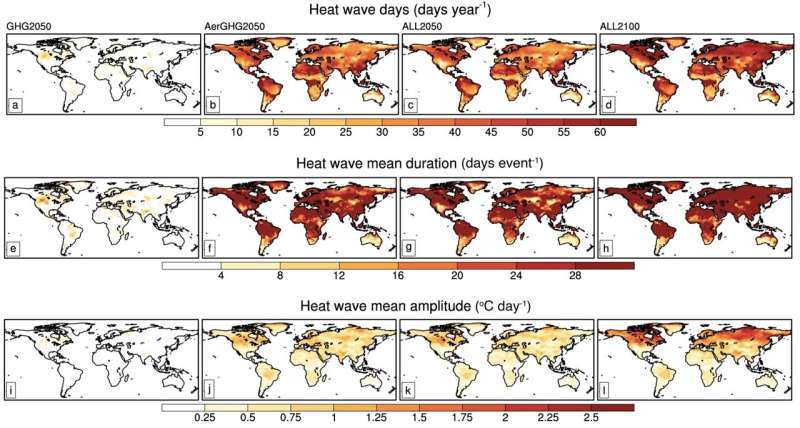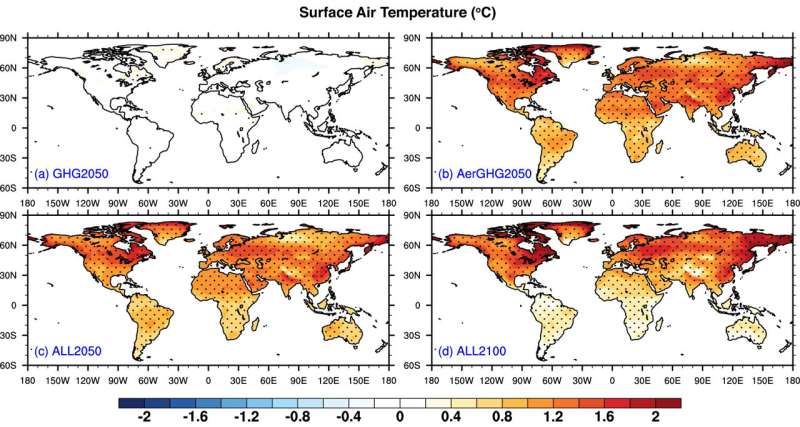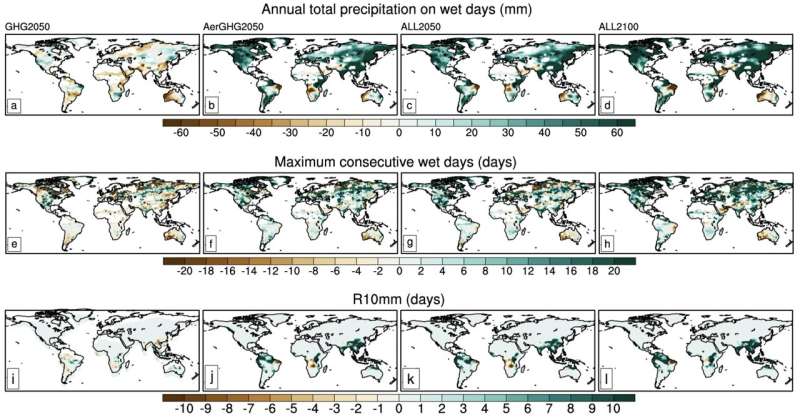November 23, 2023 feature
This article has been reviewed according to Science X's editorial process and policies. Editors have highlighted the following attributes while ensuring the content's credibility:
fact-checked
peer-reviewed publication
trusted source
proofread
Carbon neutrality likely to increase extreme weather events by 2050, finds study

Climate modeling based upon Earth's current greenhouse gas emissions trajectory predicts a worst-case scenario of 4.3°C warming of the planet by 2100 if sufficient measures are not implemented. While the Paris Climate Agreement has been adopted by 195 countries and states, aiming to limit the global temperature increase to 2°C (preferably 1.5°C) above pre-industrial levels by 2100, the Intergovernmental Panel on Climate Change reported a 1.1°C increase up to 2020.
The comprehensive study also maintained that greenhouse gas emissions must peak by 2025 and decline by 43% thereafter for the rest of the century in order to reach this 1.5°C target.
Though implementing strategies to counteract greenhouse gas emissions and reach carbon neutrality by 2025 is a primary focus, new research published in Nature Communications has outlined the ever-pressing issue of atmospheric aerosols and their counterproductive effect on climate warming.
Not only this, but work by Associate Professor Pinya Wang, of Nanjing University of Information Science & Technology, China, and colleagues has highlighted the elevated frequency and intensity of extreme weather events (from flooding to heat waves) in the future and the impact this may have on communities globally, based upon a global surface air temperature and annual mean precipitation increase of 0.92°C and 0.10mm per day by 2100.
Using the Community Earth System Model, the research team determined that a decline in atmospheric aerosols negatively impacts global climate, exacerbating extreme weather occurrence more than changes in greenhouse gases or the tropospheric ozone layer (up to 10km above ground level).
Despite this, the three are intricately linked, with Wang and colleagues noting that reducing greenhouse gas emissions, especially from processing and burning fossil fuels, consequently reduces the formation of other pollutants, such as tropospheric ozone and aerosols.
This ozone forms via chemical reactions of emissions from vehicles and smokestacks, often presenting itself in the form of smog prevalent in cities, with Dammam in Saudi Arabia most recently topping the list for problematic atmospheric particulate pollution.
China is often cited as a country prone to smog, and recent work has found that vehicle and smokestack emissions of sulfur dioxide, nitrogen oxides, primary particulates <2.5μm diameter and volatile organic compounds would need to be reduced by a substantial 93%, 93%, 90%, and 61% respectively to reach carbon neutrality by 2060.

Tropospheric ozone impacts the planet's temperature by increasing radiative forcing, trapping more incoming solar radiation, while aerosol particulates can have opposing effects (sulfates cool and black carbon warms, for example). The scientists cite recent research focused on the impact of the coronavirus pandemic on extreme weather, determining elevated wildfire occurrence in the United States in 2020 as a result of reduced aerosol emissions increasing air temperature and decreasing humidity.
The research team modeled the forcing from each of greenhouse gases, ozone and aerosols under carbon neutrality Shared Socioeconomic Pathway 1–1.9, where carbon dioxide concentrations peak at 437ppm by 2050 and decline to 400ppm by 2100, and methane reduces from current 1,884ppb to 1,061ppb by the end of the century. Under this same scenario and time frame, sulfur dioxide emissions would also decline from current 3gm−2a−1 to 1gm−2a−1, black carbon from 1gm−2a−1 to 0.1gm−2a−1 and organic carbon 0.2gm−2a−1 to 0.14gm−2a−1.
Relative to a 2020 baseline, Wang and colleagues determined an overall increase in surface air temperature across the planet by 2050 as radiative forcing increases, peaking at 0.2°C over Greenland, based on greenhouse gas emissions alone.
However, once aerosols were included, surface air temperatures across Earth significantly rose in the models, reaching a maximum of 2°C throughout the mid-high Northern Hemisphere latitudes, though this could be modulated by a slight decrease from the effect of tropospheric ozone. Projecting to 2100, aerosol-reduction warming continues to increase surface temperature.
Similarly, the model identified annual mean precipitation changes across the planet under the same forcings, finding tropical oceans (especially the Western Pacific) experienced increased rainfall under greenhouse gas-only forcing. Adding a reduction in aerosols to the simulation forcing exacerbated rainfall throughout the Northern Hemisphere, but had an opposing effect across the Southern Hemisphere, while reduced tropospheric ozone had little impact.
South, East and Southeast Asia are modeled to experience the greatest increase in precipitation, reaching 0.3mm per day. This pattern remains the same throughout the rest of the century, but with a larger amplitude, resulting from increased atmospheric water vapor due to the warmer temperatures enhancing evaporation and therefore specific humidity.

Combined, these extreme temperature and precipitation models were used to simulate the frequency and magnitude of heat waves, under greenhouse gas-only forcing being five days per year lasting four days per event with a temperature increase of 0.25°C per day.
However, with the inclusion of aerosol abundance declining, a significant exacerbation in heat wave intensity was modeled, occurring over 40 days per year, with each event lasting 20 days and a daily global temperature rise of 0.75°C per day by 2050. At the turn of the century, these figures increase further still, with 50 days per year experiencing heat wave conditions and individual events lasting 28 days with 1.5°C daily temperature fluctuations.
This research highlights the continued need to find more sustainable solutions to not only tackling greenhouse gas emissions, but associated pollutants too, to give the world a better chance at reaching ambitious targets and mitigate against the plethora of environmental, economic and social impacts that global warming is likely to cause in the decades and generations to come.
More information: Pinya Wang et al, Aerosols overtake greenhouse gases causing a warmer climate and more weather extremes toward carbon neutrality, Nature Communications (2023). DOI: 10.1038/s41467-023-42891-2
Journal information: Nature Communications
© 2023 Science X Network




















